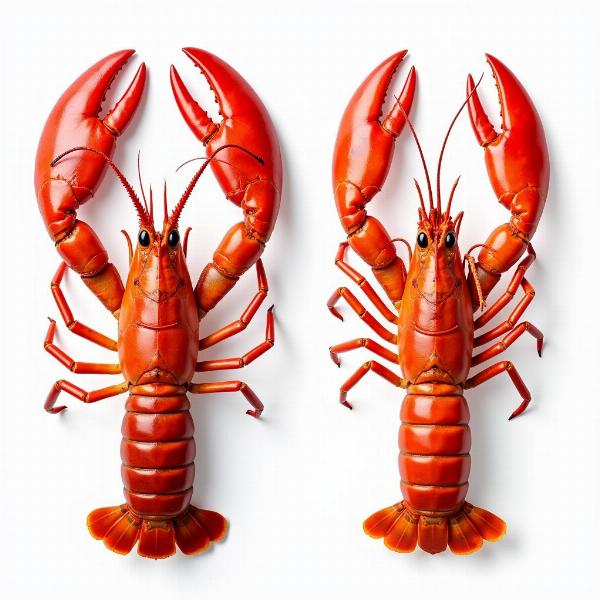Lobster, a delicacy relished worldwide, often sparks curiosity about its Hindi equivalent. Understanding the cultural nuances and linguistic context surrounding this term enhances appreciation for both the cuisine and the language. This article delves into the various aspects of “lobster meaning in Hindi,” exploring its translations, cultural significance, and culinary context within India.
Decoding “Lobster” in Hindi
While a direct, single-word equivalent for “lobster” doesn’t exist in traditional Hindi, several terms capture its essence. The most common translation is झींगा (pronounced “jheenga”), which broadly refers to prawns and large shrimp. However, this doesn’t fully encompass the specific characteristics of a lobster. Therefore, to be more precise, समुद्री झींगा (samudri jheenga) – literally “sea jheenga” – or बड़ा झींगा (bada jheenga) – meaning “large jheenga” – are often used.
Lobster’s Culinary Presence in India
Although lobsters aren’t native to Indian waters, they are becoming increasingly popular in upscale restaurants and coastal cities. This rising presence has led to a greater need for a specific term, and often, the English word “lobster” itself is used, especially on menus. The growing demand reflects India’s evolving palate and the increasing globalization of its culinary landscape.
Regional Variations in Terminology
Like many words, variations exist across different regions of India. In some coastal areas, terms derived from local dialects might be used to refer to lobster-like crustaceans. This linguistic diversity further enriches the exploration of “lobster meaning in Hindi.”
Beyond “Jheenga”: Other Descriptive Terms
Besides “jheenga,” descriptive phrases are sometimes used to convey the idea of a lobster. These might highlight the creature’s size, shell, or claws, offering a more detailed picture for those unfamiliar with the English term. For instance, केकड़े जैसा झींगा (kekde jaisa jheenga), meaning “crab-like jheenga,” could be used to emphasize the lobster’s hard shell and prominent claws.
“Lobster Meaning in Hindi”: A Cultural Perspective
The lack of a single, universally accepted Hindi word for “lobster” reflects its historically limited role in Indian cuisine. Traditional Indian food focuses heavily on locally sourced ingredients, and with lobsters not being native, they haven’t traditionally been a staple. However, the increasing adoption of the English word “lobster” itself signifies its growing acceptance within Indian culinary culture.
Understanding the Nuances: Why “Jheenga” Isn’t Always Enough
While “jheenga” serves as a general translation, it’s crucial to understand its broader meaning. Using “jheenga” when specifically referring to a lobster might lead to confusion, especially in culinary contexts. Clarifying with additional descriptors like “samudri” (sea) or “bada” (large) helps ensure accurate communication.
 Visual Comparison Between a Lobster and a Jheenga (Prawn)
Visual Comparison Between a Lobster and a Jheenga (Prawn)
Conclusion
Understanding “lobster meaning in Hindi” goes beyond a simple translation. It involves appreciating the cultural and culinary context within India. While “jheenga” provides a starting point, using descriptive phrases or the English term “lobster” itself often ensures clearer communication. As India’s culinary landscape evolves, so too will the language used to describe its diverse and expanding ingredients.
FAQ
- What is the Hindi word for lobster? While a single, perfect equivalent doesn’t exist, “jheenga” (झींगा) is often used, with additions like “samudri” (sea) or “bada” (large) for clarification.
- Are lobsters commonly eaten in India? While not traditionally a staple, they are gaining popularity in upscale restaurants and coastal areas.
- Why is “jheenga” not always sufficient when referring to lobster? “Jheenga” refers broadly to prawns and shrimp; using it for lobster might create confusion, especially in culinary contexts.
- What are some other ways to describe lobster in Hindi? Descriptive phrases emphasizing the lobster’s size, shell, or claws can be used.
- Is it acceptable to use the English word “lobster” in India? Yes, particularly in menus and upscale dining settings, the English term is commonly used and understood.
- Are there regional variations in the Hindi terms for lobster? Yes, local dialects in coastal areas may have specific terms for lobster-like crustaceans.
- Where can I find lobster in India? Upscale restaurants and seafood markets in coastal cities are the most likely places to find lobster.
Meaning-Hindi.in is your trusted partner for professional Hindi translation services. We specialize in a wide range of translation needs, including business and commercial documents, legal and certified translations, technical manuals, website localization, educational materials, and specialized industry content. Our expertise ensures accurate and culturally appropriate translations, bridging linguistic gaps and facilitating effective communication. Contact us today for all your Hindi translation requirements: Email: [email protected], Phone: +91 11-4502-7584. Meaning-Hindi.in is dedicated to providing high-quality, reliable translation services that meet your specific needs.